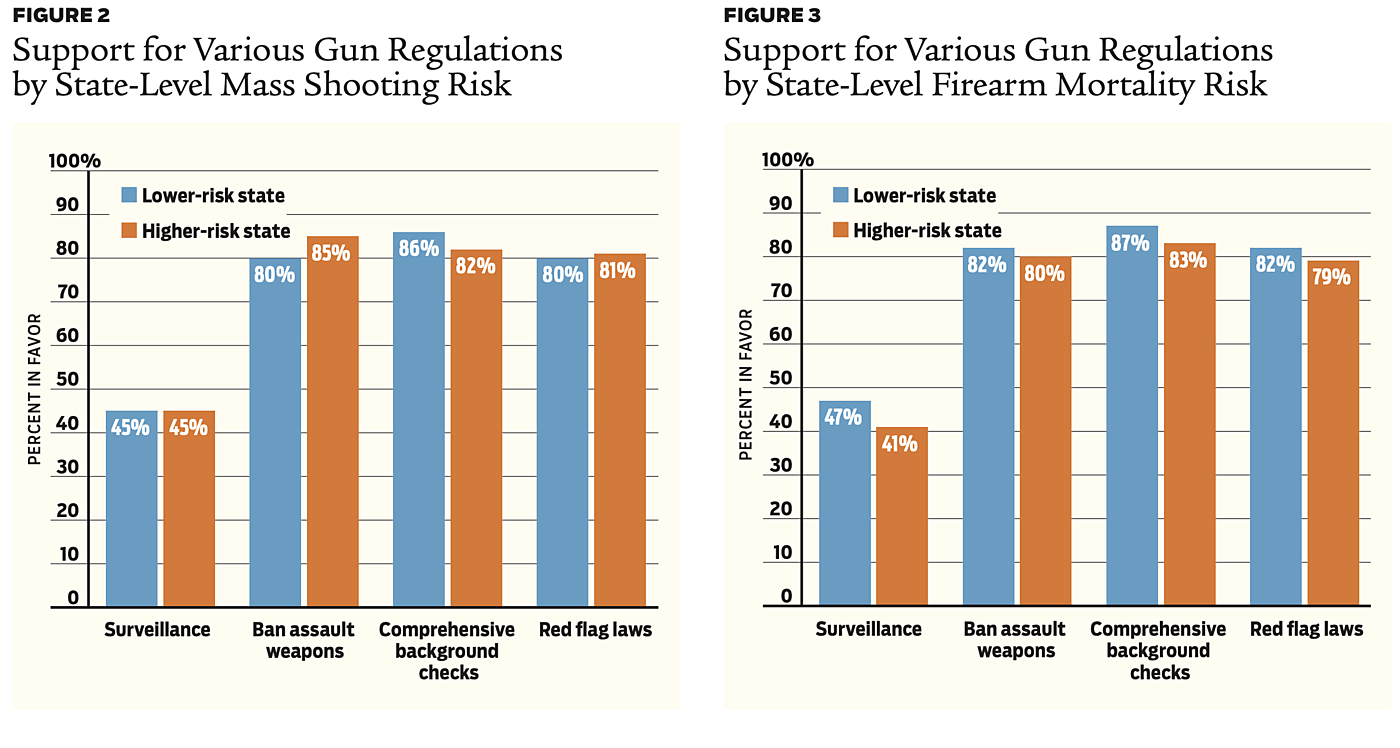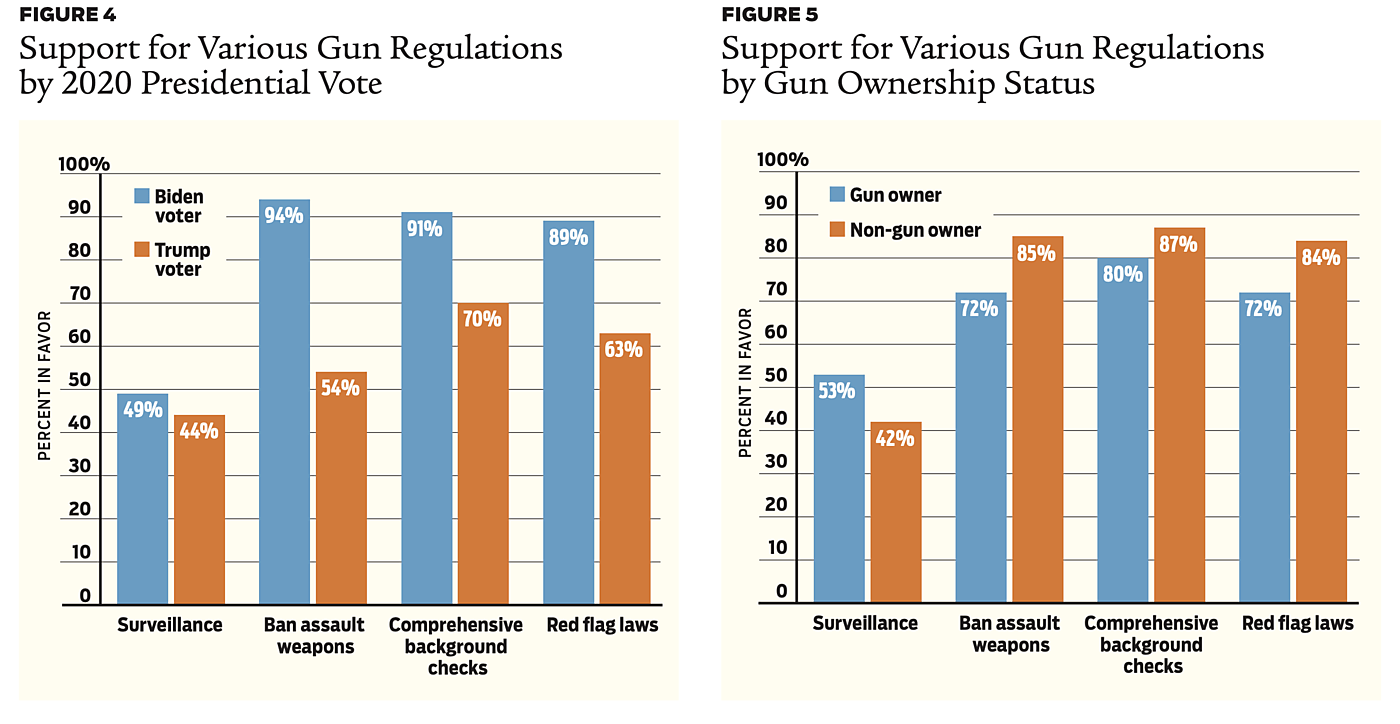The mass shootings earlier this year that killed 10 people at a Buffalo, New York, supermarket and 19 children and two teachers at an elementary school in Uvalde, Texas, have renewed interest in legislation to combat these crimes. Mass shootings, which are defined as incidents in which firearms are used to shoot or kill at least four victims excluding the shooter, have increased in frequency in recent decades, garnering massive media attention and provoking public concern. The increased public concern led federal lawmakers to agree to a package of gun regulations this summer.
Mass shootings are responsible for only a very small percentage of the deaths caused by gun violence in the United States, but most gun regulations motivated by a concern with mass shootings likely would have broader effects on gun violence generally. They would also likely affect lawful gun ownership and use. Accordingly, political ideology plays a role in gun regulation efforts, as supporters of gun rights usually muster opposition to these measures while gun rights skeptics push for them.
This article examines survey results on how ideology and vulnerability affect attitudes toward gun regulation. It finds that ideology is more of a driver of differences in these views than the personal risk of gun violence. Nonetheless, the survey data find majority support among opposed political groups for some gun regulations—including some of the regulations incorporated in the new federal legislation.
Survey
In May 2021, I used Amazon’s Mechanical Turk crowdsourcing website to survey Americans on their attitudes toward gun policy. The 704 respondents analyzed here considered a series of questions on their support or opposition to various regulations often proposed to combat mass shootings. The general form of these questions is reflected in this one regarding assault weapons and ammunition magazines: “Would you favor a ban on assault weapons and high-capacity magazines if these measures would reduce deaths from mass shootings?”
The survey also considered three other types of proposals. One would make it easier for legal authorities to read mail, email, social media posts, and tap phones without a person’s knowledge provided that it was related to preventing mass shootings, which for succinctness I will refer to as “surveillance.” Such efforts don’t affect direct control of gun ownership but may help to identify impending threats.
Another proposal would broaden comprehensive background checks on prospective firearms buyers, including purchases through private sales not involving a licensed dealer. This could help sellers identify people who are legally prohibited from buying a gun. The policy option specified in my survey pertained to all age groups, not just those under age 21.
The final policy option would deprive people of gun ownership rights if their mental condition suggests that they pose a threat. The survey described these policies as “red flag laws,” also called “extreme risk protection orders,” and they would enable the courts to temporarily seize firearms from people who are believed to be a threat to themselves or others.
Overall support / The degree of overall support for these measures is substantial, except for reading mail and related surveillance efforts. Figure 1 presents the overall percentage support for each of the four proposals. Under half of all respondents would support efforts to monitor people’s mail and social media communications for purposes of reducing mass shootings. The support for the other measures, which are more directly focused on gun regulations, is much greater. In each case, at least four-fifths of the respondents support the measures, with 81% favoring red flag laws and banning assault weapons, while 85% favor background checks.

Exposure to gun risk / As the ongoing debate over gun regulation attests, support for regulatory measures is likely to differ across the U.S. population. People who are likely to benefit the most from gun regulations—that is, people who are at heightened risk of being victims of gun violence—should have the greatest stake in regulations intended to reduce these risks.

I searched for this relationship in my survey data. The first risk measure that I used to capture risk-related support was whether the respondent lives in a state that has a rate of mass shootings above or below the national median. History of mass shootings in the state should lead people to perceive a greater personal risk reduction from gun regulation measures designed to reduce mass shootings.
Figure 2 summarizes the survey responses for residents of states with above- and below-median mass shooting risk. The only regulations for which there is greater support if the person lives in a high mass shooting state are bans on assault weapons, for which there is 5% greater support, and red flag laws, for which there is 1% greater support. For all four proposals, there are no statistically significant differences in support based on the level of the mass shooting risk in the state.
Conceivably, a broader measure of firearm risk would be more strongly correlated with support of gun regulations. The number of deaths from mass shootings is more than an order of magnitude lower than the number of firearms-related homicides, so risk of gun-related homicide may be more of a factor. Besides, while the survey specifically inquired about the support for these regulations to reduce mass shootings, various gun laws also will affect gun-related risks more generally.
Figure 3 presents the support for the different gun regulations for respondents in states that are above or below the median national firearms death rate. While there is consistent general support for the gun policies among residents of higher-risk states, the differences between the low-risk states and high-risk states are never statistically significant. The greatest spread is for surveillance efforts, for which there is a 6 percentage point difference. However, for both groups, the support for that kind of regulation is under 50%. Personal exposure to firearms-related risk is not a driver of support for these measures.
Ideology / Political orientation is a more consequential determinant of support. Figure 4 breaks down the sample between those who voted for Joe Biden in the 2020 election and those who voted for Donald Trump. The surveillance policy option continues to be viewed unfavorably by both political groups. The other three interventions generate much more polarized reactions. Biden voters support these measures at levels from 89% to 94%, while those who voted for Trump are less supportive.
The greatest gap is observed for banning assault weapons, for which there is a 40-percentage point difference in support for these gun laws. The other political disparities are substantial as well, but it is noteworthy that at least 54% of those who voted for Trump support banning assault weapons, background checks, and red flag laws. Those who voted for Trump find background checks to be the most generally acceptable of the four proposals, followed by red flag laws.
Another possible factor in gun policy preferences is whether the respondent would be personally affected adversely by the regulations, as measured by whether the respondent owns a gun. Figure 5 presents the support for the different measures as a function of gun ownership. Interestingly, non–gun owners are less likely to support screening of mail and surveillance, presumably because they view this as a civil liberties issue.
For the other three policies, the differences follow the same patterns as did the voting in the 2020 presidential election. Non–gun owners are more supportive of banning assault weapons, background checks, and red flag laws. Still, for these three policies, the level of support by gun owners is at least 72%. The greatest disparity between those with and without guns is for banning assault weapons, which is the most direct intrusion into the ability to possess particular types of firearms. However, the differences in political support based on gun ownership are less pronounced than for political orientation as reflected in their vote in the presidential election.
Going Forward

Recent tragedies have stimulated interest in exploring policy remedies to control gun violence, particularly mass shootings. Wholly apart from the immediate policy relevance of mass shootings, the public places a very high value on reducing deaths from these incidents. In a 2021 article, recent Vanderbilt Law and Economics graduate Rachel Dalafave and I found that the public values preventing mass shooting deaths about 60% more highly than preventing deaths from terrorist attacks. (See “Risk–Risk Tradeoffs for Mass Shootings and International Terrorism,” Risk Analysis, 41[12]: 2196–2208 [2021].) While the government has embarked on vigorous anti-terrorism efforts, there have been few initiatives to control firearms risks.
The survey results reported here indicate a potential source of this policy stalemate. Some policy options, such as reading mail and internet correspondence to identify potential risks, are broadly unpopular. There are polarized views of other policies directed at banning assault weapons, background checks, and red flag laws, but all have substantial support generally. There is also no significant variation in levels of support based on measures of personal risk of gun violence. Political orientation is the principal driver of the divisions, and these political divisions are more consequential than gun ownership. There is, nevertheless, substantial support for many regulatory initiatives, even among groups with political preferences that tend to not be favorable to gun control. This helps to explain why federal lawmakers agreed to include provisions promoting red flag laws and expanding background checks for younger gun buyers in the recently approved gun legislation.
Political support alone is not the determinant of which policies should be pursued, of course. Gun regulations should be subject to the same types of benefit–cost inquiries as other policies. For instance, red flag laws do not appear to be effective in reducing homicides, though they do appear to reduce suicides, as Dalafave found in different research. (See “An Empirical Assessment of Homicide and Suicide Outcomes with Red Flag Laws,” Loyola University Chicago Law Journal 52[3]: 867–905 [2021].) Of the three options other than reading mail and related surveillance efforts, banning assault weapons and background checks may merit the greatest scrutiny regarding their overall merits.

This work is licensed under a Creative Commons Attribution-NonCommercial-ShareAlike 4.0 International License.
